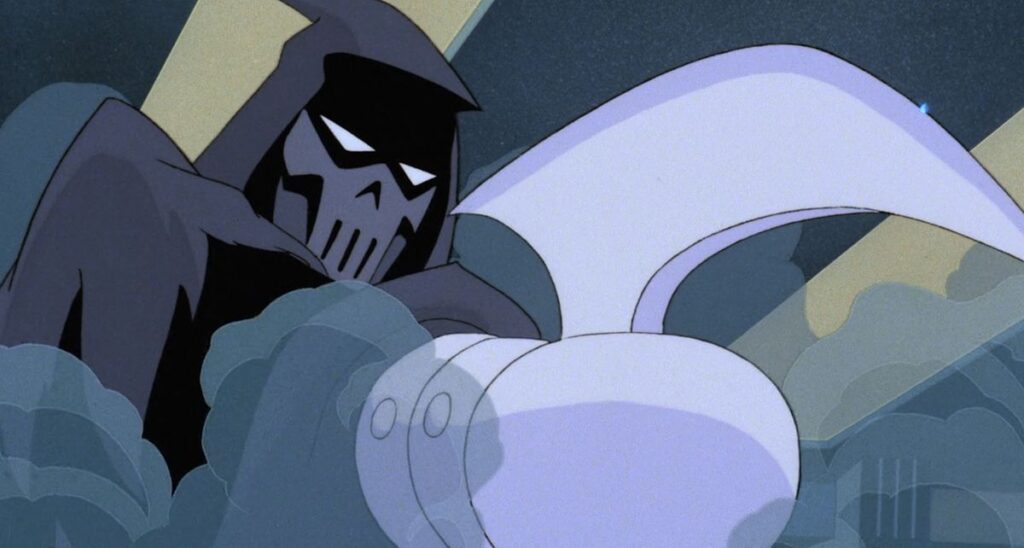As a teenage comic book fan coming of age as superheroes were breaking into the mainstream, I always approached any conversation about Batman with a hipster’s sense of ownership. Like any comics nerd with a punk-rock attitude toward superhero comics (possibly the least punk-rock thing in the world), I knew, without a doubt, that the best Batman movie was the one the normies hadn’t heard of — the 1993 animated feature Batman: Mask of the Phantasm.
At the time, there was much less competition for the title. The campy 1966 Batman movie starring Adam West was, in the ’90s and early 2000s, considered an embarrassment, the reason your parents mocked any interest in the character. None of the sequels to Tim Burton’s 1989 blockbuster had repeated its commercial or critical success, and though they each had (and still have) their defenders, the ’89 film was the cultural touchstone, the default answer for both “best Batman movie” and “best comic book movie.” But for a young, snobbish superhero fan, there’s nothing more satisfying than feeling like you know something the mass audience doesn’t.
Image: Warner Bros. Animation
Mask of the Phantasm was an obscurity in the days of the early internet — a feature-length episode of Batman: The Animated Series that was upgraded from direct-to-video to a Christmas Day theatrical release without much fanfare. It found its audience later on VHS, on Cartoon Network, or via Siskel and Ebert’s delayed recommendation two years later. In my case, I received a VHS copy of Mask of the Phantasm on my 5th birthday from my late Great-Aunt Toby. Bless her memory, she had no idea what she’d bought for me, much less that it would have such an impact on the course of my life.
It’s now been 30 years since Mask of the Phantasm landed in theaters on Christmas, and there are a lot more contenders for the title of Best Batman Movie. Castoffs like Batman ’66 and Batman Returns have been positively reevaluated. There are multiple overlapping Batman film series that have achieved not only commercial success, but critical respect rarely earned by rival superhero franchises. And the public still hasn’t forgiven AMPAS for denying 2008’s The Dark Knight a Best Picture nomination.
In the interval since Phantasm first came out, I’ve grown up and become a professional film critic, and like so many in my line of work, I’ve burned out on the proliferation of superhero cinema. I used to regularly revisit the Batman films, even the ones I don’t particularly love. Now I’ll go years between viewings, save for Batman Returns, the most anti-franchise franchise movie ever made, which I watch every Christmas. Even so, I think Mask of the Phantasm is still the best Batman movie.
But can I critically justify that opinion? To mark Mask of the Phantasm’s 30th birthday, I pitted it head-to-head with the other films considered to be the best in the franchise to see whether my childhood favorite really holds up to my adult film-critic eyes.
Mask of the Phantasm vs. Batman (1989)

Photo: Warner Bros./Everett Collection
The 1989 Batman is the record-breaking blockbuster that made the character cool to Gen X-ers and opened the door for more adult-targeted films about costumed pulp heroes. (It is, in hindsight, hilarious that Batman’s colossal success led to the production of major motion pictures based on Dick Tracy, The Shadow, and The Phantom, and yet there wouldn’t be another Superman movie until 2006.)
While Batman was praised on release for its “dark and gritty” depiction of Gotham and its masked defender, hindsight and a modern rewatch reveals Burton’s Batman to be every bit as cartoony as the 1966 version. It’s simply a bloodier, meaner cartoon. From Anton Furst’s expressionistic Gotham cityscape to Jack Nicholson’s off-the-wall performance as the Joker, it’s a Bronze Age comic brought to life, complete with a lot of broad prop comedy.
This makes it the closest kin to Mask of the Phantasm, whose parent animated series was heavily inspired by the ’70s comics runs of Dennis O’Neil, Neal Adams, Steve Englehart, and Marshall Rogers. Both films establish Gotham City as a timeless pulp-fiction setting rather than a real place, an atmosphere best summed up by Nicholson’s Jack Napier: “Decent people shouldn’t live here. They’d be happier someplace else.”
Burton’s Batman bears the burden of reintroducing the character as a concept, and screenwriter Sam Hamm wisely treats the Caped Crusader like a classic Universal Monster. The story is about him, but he isn’t really the protagonist — that would be photojournalist Vicki Vale (Kim Basinger), who’s digging into the myth of Gotham City’s bizarre new vigilante and the life of her would-be boyfriend, eccentric billionaire Bruce Wayne (Michael Keaton), unaware that they are one and the same.
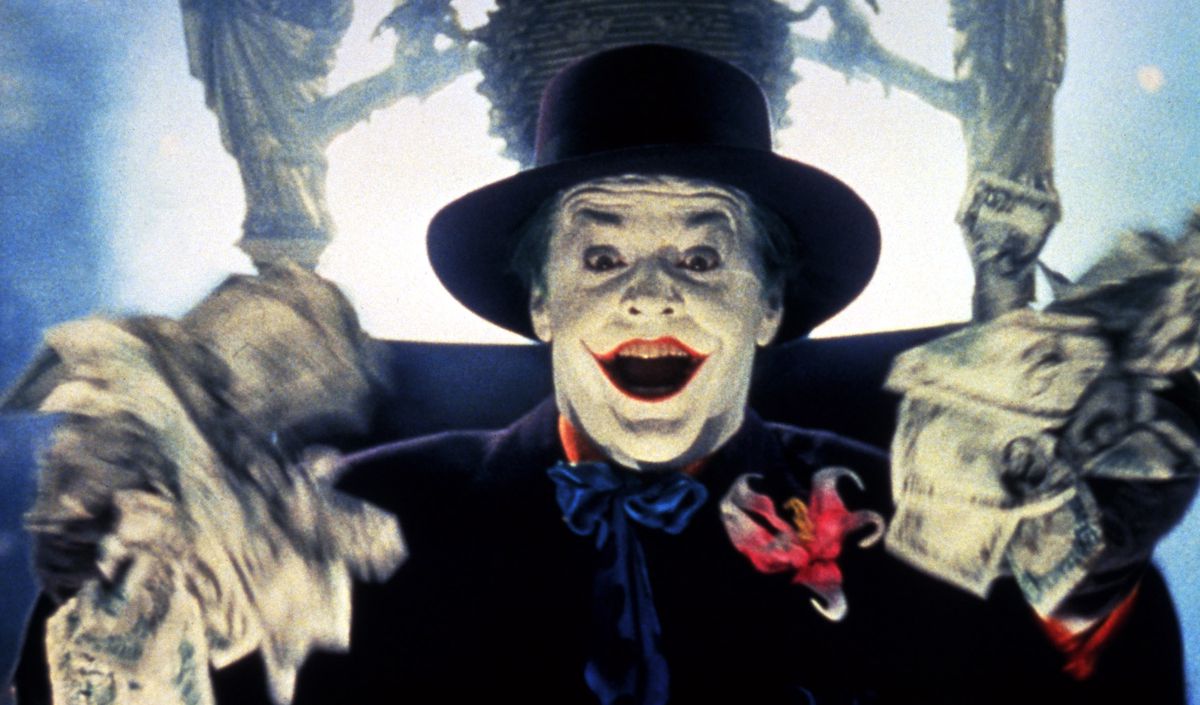
Photo: Warner Bros./Everett Collection
Of the film’s three leads, Bruce/Batman actually receives the least screen time, with the most going to Nicholson’s Joker. (Nicholson also got top billing in the movie.) By the end of the film, Bruce Wayne is still an unknowable weirdo, but he’s the unknowable weirdo Vicki loves — and by extension, the audience loves too. But Vicki’s role as audience stand-in also leaves her relatively bland and unexplored, and as a result, the love story isn’t terribly convincing.
Mask of the Phantasm is also both a mystery and a romance, but it’s far more invested in exploring Bruce Wayne (Kevin Conroy) as a character. While it’s set primarily at the height of his career as Batman, the return of a lost love prompts Bruce to flash back to a pivotal moment in his life, when he almost aborted the Batman experiment to marry whip-smart socialite Andrea Beaumont (Dana Delany).
Meanwhile, he’s chasing a serial killer who’s targeting the Mafia, but in a reversal of the ’89 Batman, Bruce doesn’t know his love interest and the subject of his investigation are the same person. On repeat viewings, it becomes clear that Bruce’s flashbacks are just as much an origin story for Andrea as they are for him. Ironically, this makes both animated leads more realistic and textured than their live-action counterparts from 1989, making Mask of the Phantasm Batman’s most compelling on-screen romance by a mile.
By a lot of other metrics, Batman ’89 and Mask of the Phantasm are neck and neck. Both films’ version of Joker are sickly funny malevolent imps who casually defy physical laws for the sake of comedy. (Phantasm features the defining performance of Mark Hamill’s 30-year tenure with the character.) Batman makes Joker the star, while Mask of the Phantasm brings him in at its midpoint to kick the story into a new gear.
Both approaches work brilliantly. Danny Elfman’s rousing Batman march is a perfect fit for a broad action film, while Shirley Walker’s Mask of the Phantasm theme, extrapolated from her work on The Animated Series, captures the totality of the character better than any musical composition before or since. There’s a richness and mournfulness to Walker’s main theme that forecasts the emotional journey ahead, and that journey ultimately gives Mask of the Phantasm the edge, in my book.
Mask of the Phantasm vs. The Dark Knight

Photo: Warner Bros./Everett Collection
Burton’s Batman was a Hollywood game-changer financially, proving the box-office appeal and broad cultural viability of pulpy comic book adaptations. But it was Christopher Nolan who shattered the proverbial skylight for superhero cinema on a critical level. On top of its billion-dollar gross, The Dark Knight won an Oscar for late actor Heath Ledger, and its absence from the Best Picture category has been cited as the reason the Academy doubled the number of nominees the following year.
It’s the highest-rated DC Comics film adaptation on Rotten Tomatoes, and as of this writing it’s currently the 24th best-reviewed narrative film on Letterboxd. By most metrics, this is the movie to beat. And yet, perhaps because of its enormous reputation, revisiting The Dark Knight was a bit of a disappointment.
True, Mask of the Phantasm doesn’t hold a candle to The Dark Knight on any technical level. The Dark Knight is a gargantuan feat of practical IMAX spectacle, helmed by one of Hollywood’s last great auteurs. Mask of the Phantasm was ground out through essentially the same workflow as an animated television series. Its visuals are effective, but rarely profound. It would be lunacy to say that Phantasm is better cinema than The Dark Knight. Nevertheless, where The Dark Knight demonstrates the incredible amount of labor that goes into telling this story, Mask of the Phantasm makes it look easy.
Like nearly all Warner Bros.’ live-action Batman adaptations, The Dark Knight is terribly self-conscious about the very idea of Batman, and is determined to convince a skeptical audience that the character should be taken seriously. Christopher Nolan and writing partners David S. Goyer and Jonathan Nolan are shockingly good at selling Batman, his world, his methods, and his gadgets as logical, practical things that could exist in the real world.
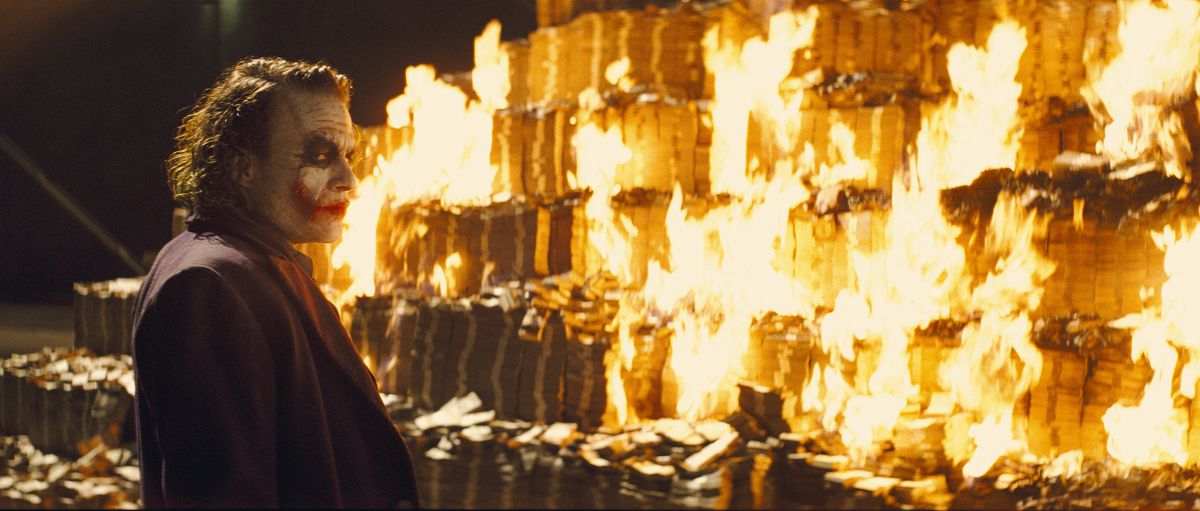
Photo: Warner Bros./Everett Collection
But in The Dark Knight, making Gotham feel like a real place also makes it feel generic. Mask of the Phantasm’s Gotham is an art deco retrofuturistic setting; The Dark Knight’s Gotham has no identity whatsoever. Gone are the unique quirks and landmarks established in Batman Begins, like the elevated train line or the hellish slums, the Narrows. The Dark Knight was shot on location in Chicago, but it avoids recognizable Chicago landmarks and replaces them with nothing, as if adding any set dressing would inherently make the setting less real, and by extension less “adult.”
This is a serious problem, because the movie tells us over and over that Gotham is changing, giving birth to copycat vigilantes and outlandish costumed villains. Making the city more grounded and less weird is completely at odds with the film’s themes. How can we invest in Batman (Christian Bale) and the Joker (Ledger) as they battle for the city’s soul, when it doesn’t have one to begin with? (It’s unfair to hold this against The Dark Knight, but Joker’s claim that Batman’s costumed escapades have “changed things forever” are also totally undercut by The Dark Knight Rises, which implies that Gotham had neither a Batman nor any need for one for the following eight years.)
A head-to-head matchup between Mark Hamill’s animated Joker and Heath Ledger’s live-action Joker is essentially impossible. They’re completely different, they play totally different roles in their respective films, and they’re both perfect. However, Conroy and Bale’s Bruce Waynes share a similar emotional journey. Both portrayals capture something essential about the character as he’s been portrayed in the comics since at least the late ’70s: Where other superheroes struggle to maintain some semblance of a normal life, Bruce Wayne is trying his damnedest not to live one.
Both The Dark Knight and Mask of the Phantasm depict the incident that convinces Bruce to abandon any hope of a happy personal life, in the death of assistant district attorney Rachel Dawes (Maggie Gyllenhaal) and the disappearance of Andrea Beaumont, respectively. Bale-Batman’s heartbreak has an extra element of tragedy, as Rachel’s death seems to fulfill her own prophecy that Bruce will never give up his alternate identity. (Until he does exactly that the moment the movie is over. Thanks again, Dark Knight Rises.) Still, in spite of the advantages of portraying human drama in live action, no emotional moment in The Dark Knight feels as weighty or sincere as Phantasm’s scene of young Bruce kneeling at his parents’ grave, begging for permission to abandon his crusade, or the parting moments with Bruce and Andrea at the end of Mask of the Phantasm.
Mask of the Phantasm vs. The Batman (2022)
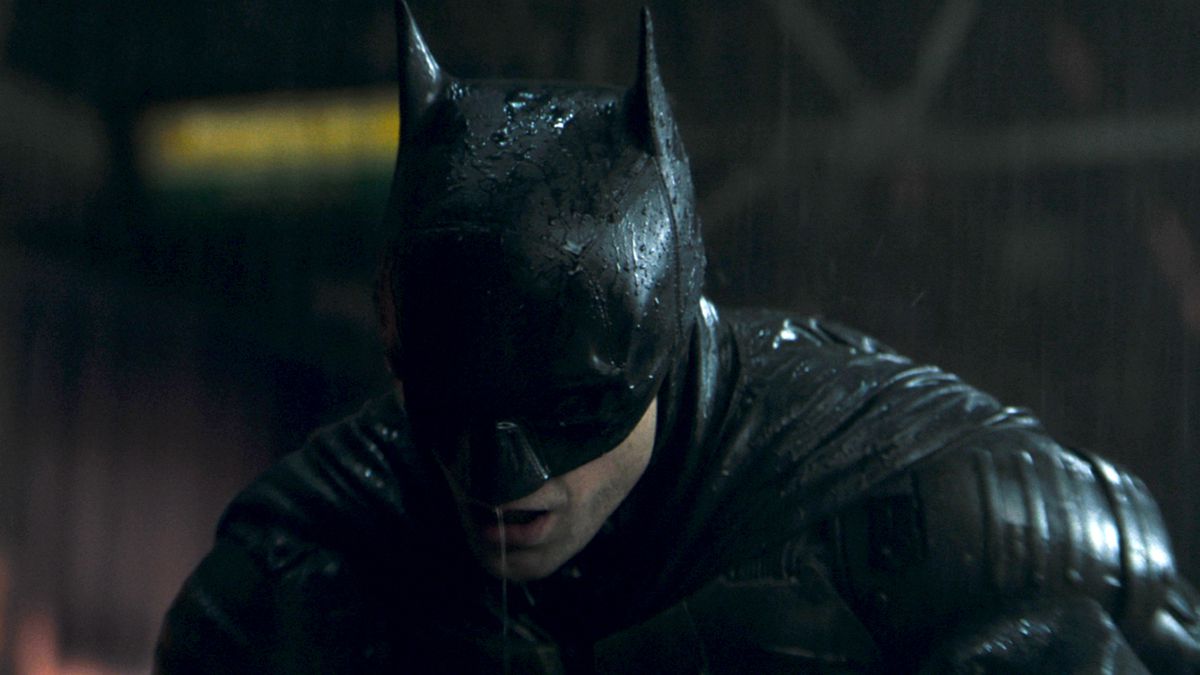
Image: Warner Bros. Pictures
Where Mask of the Phantasm is the nostalgic favorite, The Batman has recency bias in its corner. Matt Reeves’ sweaty, amber-tinged detective story has style for days and a strong sense of place, while also aiming for realism with a minimum of fantastical comic book elements. It’s tightly focused on the experience of its title character, becoming the first theatrical Batman feature to incorporate his narration, which has been a staple of the comics since the 1980s.
It’s more of a detective story than any Batman movie since Phantasm, and the most film noir entry in the entire franchise, a mystery that reveals deeper levels of systemic corruption at every turn. Noir is a perfect fit for a young-Batman story: The genre is preoccupied with the hopelessness of the modern world, and forces its protagonists to ask, “What can one man do against such injustice?” In a typical noir, the answer is usually “Not much.” But Batman can never accept this, which is both the triumph and tragedy of the character. The Batman is about Bruce Wayne (Robert Pattinson) realizing it isn’t enough to bash his fists endlessly into the face of criminality, and that if he really wants to make a difference, he’ll have to become a symbol of hope rather than fear.
Mask of the Phantasm is set 10 years into Bruce’s career as Batman, and it doesn’t really question the value or effectiveness of his vigilantism. But like The Batman, it sets its mystery plot at the intersection of gangsters and government. In Phantasm, somebody’s bumping off old mobsters, and the trail leads to missing businessman Carl Beaumont (Stacy Keach) and his former assistant, Arthur Reeves (Hart Bochner), who is now a city councilman. The Batman’s case is the reverse of that, as the Riddler (Paul Dano) assassinates several government officials, revealing their dirty dealings with Mafia boss Carmine Falcone (John Turturro). This conspiracy unwinds through quiet detective work, stakeouts, and interrogations, with the occasional fight or chase scene, always feeling more like a thriller than an action movie.

Image: Warner Bros. Pictures
At least, until The Batman’s third act, when the stakes suddenly ratchet up from “serial killer” to “city-wide apocalypse.” The escalation is jarring, almost as if a studio executive took a look at the script and said, “Hold on, this needs to cost $200 million.” It’s not that Batman stepping out of the shadows to help Gotham survive and recover from a massive disaster isn’t an appropriate ending for the film, it’s just a big leap to place so late in a three-hour movie.
By comparison, Mask of the Phantasm, which runs a scant 76 minutes, is incredibly efficient and scales beautifully, in part because it has more manageable stakes. Unlike most Batman features, Phantasm doesn’t actually put the entire city in jeopardy, only Batman’s life and reputation, and Andrea Beaumont’s soul. In a brilliant stroke, however, director Eric Radomski and the rest of Team Phantasm set their climax in the ruins of the Gotham World’s Fair, a futuristic city in miniature that Joker has wired to explode.
Not only does this mimic the spectacle of a massive disaster, but since the World’s Fair was the setting of one of Bruce and Andrea’s romantic flashbacks, its destruction has great symbolic value. The final confrontation between Bruce and Andrea is set in the burning ruins of the life they might have had together, and it feels like the end of the world.
Mask of the Phantasm vs. blockbuster thinking
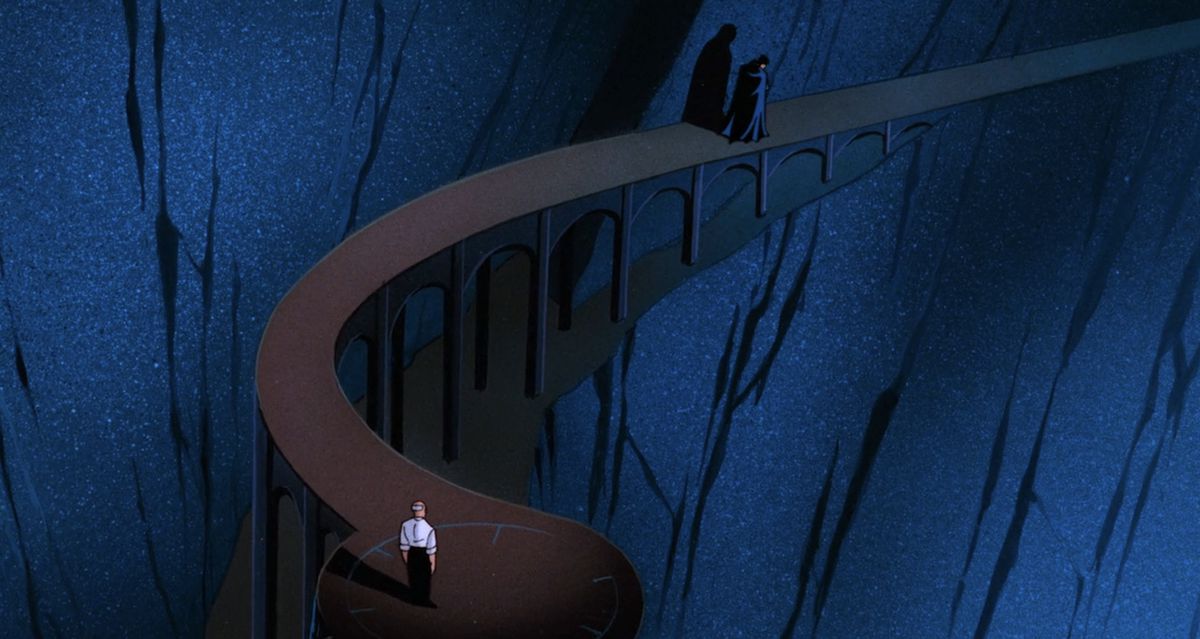
Image: Warner Bros. Animation
Perhaps it’s Mask of the Phantasm’s relative smallness that makes it so appealing to me as a Batman comics fan. When a studio gives the green light to a live-action Batman feature, their aim is to make a tentpole, an epic, “the biggest Batman yet.” And in the comics, the big multi-part crossovers are rarely as powerful as the smaller, episodic mysteries or character stories.
Since Mask of the Phantasm wasn’t initially conceived as a theatrical feature, but as a feature-length episode of TV released direct to video, it was never saddled with the expectation of being an Event. It gets to be a Batman story, not the Batman story.
Over the course of this experiment, I scribbled down pages of notes about story structure, performances, and technical ambition, trying to apply the knowledge and skills I’ve learned as a student of cinema. But none of these scholarly bullet points are nearly as profound to me as the point in Mask of the Phantasm at which I stopped taking notes and simply sat back on the couch, clutching a pillow and choking back tears.
These live-action features may be more challenging, dazzling, or technically groundbreaking, but only Phantasm makes me feel close enough to the characters to share in their heartbreak. Once, I considered my preference toward Mask of the Phantasm to be a status symbol, a shibboleth to other “cool” Batman fans. Now, it’s almost the reverse — it’s a confession that I am an adult man who is moved to tears by an old cartoon. And honestly, cool or uncool, I’m satisfied with that.

